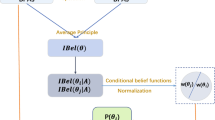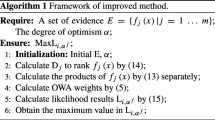Abstract
Möbius transformation is a very important information inversion tool. Möbius transformation is sought after by many experts and scholars at home and abroad, and is a hot research topic at present. Möbius transformation can use the known information to reverse the unknown information, indicating that it has a strong ability to process information. Generalized evidence theory is an extension of classical evidence theory. When belief degree of the null subset is 0, then the generalized evidence theory will be degenerated as classical Dempster-Shafer evidence theory. However, how to apply Möbius transformation to generalized evidence theory is still an open problem. This paper proposes Möbius transformation in generalized evidence theory, which can perform function inversion of generalized evidence theory effectively. Numerical examples are used to prove the validity of Möbius transformation in generalized evidence theory. The experimental results show that the Möbius transformation in generalized evidence theory can effectively invert the generalized evidence theory and is a very effective function inversion method.



Similar content being viewed by others
References
Demirel O (2020) The hyperbolic polygons of type (𝜖, n) and möbius transformations. Open Math 18:177–181, 03
Fernandez J, Bustince H, Horanská L, Mesiar R, Stupňanová A (2020) A generalization of the choquet integral defined in terms of the möbius transform. IEEE Trans Fuzzy Syst 28(10):2313–2319
Reis L (2019) Möbius-like maps on irreducible polynomials and rational transformations. J Pure Appl Algebra:05
Aigner M (1979) Combinatorial theory. Springer, New York, pp 01
Kennes R (1992) Computational aspects of the Möbius transform of graphs. IEEE Trans Syst Man Cybern 22:201–223,04
Smets P (2002) The application of the matrix calculus to belief functions. Int J Approx Reason 31:1–30,10
Liu L (2017) Representing belief functions as random variables. IEEE Trans Syst Man Cybern Syst PP:1–10, 06
Deng Y (2015) Generalized evidence theory. Appl Intell 43:530–543
Jiang W, Zhan J (2016) A modified combination rule in generalized evidence theory. Appl Intell 46:10
Koh JM, Cheong KH (2019) New doubly-anomalous parrondo’s games suggest emergent sustainability and inequality. Nonlinear Dyn 96(1):257–266
Meng D, Liu M, Yang S, Zhang H, Ding R (2018) A fluid–structure analysis approach and its application in the uncertainty-based multidisciplinary design and optimization for blades. Adv Mech Eng 10(6):1687814018783410
Weijia Lai J, Cheong KH (2020) Parrondo effect in quantum coin-toss simulations. Phys Rev E 101(5):052212
Fei L, Feng Y, Liu L (2019) On pythagorean fuzzy decision making using soft likelihood functions. Int J Intell Syst 34(12):3317–3335
Dzitac I, Filip FG, Manolescu M-j (2017) Fuzzy logic is not fuzzy World-renowned computer scientist lotfi a. zadeh. Int J Comput Commun Control 12(6):748–789
Fei L, Feng Y (2020) An attitudinal nonlinear integral and applications in decision making. International Journal of Fuzzy Systems. https://doi.org/10.1007/s40815--020--00862--5
Ares F, Esteve J, Falceto F, Queiroz A (2017) Entanglement entropy and möbius transformations for critical fermionic chains. J Stat Mech Theory Exper:063104
Pan Y, Zhang L, Wu X, Skibniewski MJ (2020) Multi-classifier information fusion in risk analysis. Inf Fusion 60:121–136
Wang H, Fang YP, Zio E (2021) Risk assessment of an electrical power system considering the influence of traffic congestion on a hypothetical scenario of electrified transportation system in new york state. IEEE Trans Intell Transp Syst 22(1):142–155
Li M, Huang S, De Bock J, De Cooman G, Pižurica A (2020) A robust dynamic classifier selection approach for hyperspectral images with imprecise label information. Sensors 20(18):5262
Xue Y, Deng Y (2021) Tsallis extropy. Communications in Statistics-Theory and Methods. https://doi.org/10.1080/03610926.2021.1921804
Xue Y-G, Deng Y (2021) A new belief structure based on cardinality measure. Comput Appl Math 40(51). https://doi.org/10.1007/s40314--021--01452--3,
Mo H (2021) A SWOT method to evaluate safety risks in life cycle of wind turbine extended by D number theory. J Intell Fuzzy Syst 40(3):4439–4452
Mo H (2020) A new evaluation methodology for quality goals extended by D number theory and FAHP. Information 11(4):206
Mo H (2020) An emergency decision-making method for probabilistic linguistic term sets extended by D number theory. Symmetry 12(3):380
Song Y, Fu Q, Wang Y-F, Wang X (2019) Divergence-based cross entropy and uncertainty measures of atanassov’s intuitionistic fuzzy sets with their application in decision making. Appl Soft Comput 84. https://doi.org/10.1016/j.asoc.2019.105703
Garg H (2019) Intuitionistic fuzzy hamacher aggregation operators with entropy weight and their applications to multi-criteria decision-making problem. Iran J Sci Technol Trans Electr Eng 43(3):597–613
Lai JW, Cheong KH (2020) Parrondo’s paradox from classical to quantum: A review. Nonlinear Dyn 100(1):849–861
Liao H, Ren Z, Fang R (2020) A deng-entropy-based evidential reasoning approach for multi-expert multi-criterion decision-making with uncertainty. Int J Comput Intell Syst 13:1281–1294
Özkan K (2018) Comparing shannon entropy with deng entropy and improved deng entropy for measuring biodiversity when a priori data is not clear. Forestist 68(2):136–140
Deng Y (2020) Information volume of mass function. Int J Comput Commun Control 15(6):3983
Pan Q, Dezert J, Huang L, Liu Z (2020) Evidential combination of augmented multi-source of information based on domain adaptation. Sci China Inf Sci 63(11):210203
Soroush MZ, Maghooli K, Setarehdan K, Nasrabadi AM (2019) Emotion recognition through eeg phase space dynamics and dempster-shafer theory. Med Hypotheses 127:03
Song Y, Zhu J, Lei L, Wang X A self-adaptive combination method for temporal evidence based on negotiation strategy. SCIENCE CHINA Information Sciences https://doi.org/10.1007/s11432--020--3045--5
Xiao F (2020) CED: A distance for complex mass functions. IEEE Transactions on Neural Networks and Learning Systems. https://doi.org/10.1109/TNNLS.2020.2984918
Shafer G (1976) A mathematical theory of evidence, vol 42. Princeton University Press
Xiao F, Cao Z, Jolfaei A (2020) A novel conflict measurement in decision making and its application in fault diagnosis. IEEE Transactions on Fuzzy Systems. https://doi.org/10.1109/TFUZZ.2020.3002431
Deng Y (2020) Uncertainty measure in evidence theory. Sci China Inf Sci 63(11):210201
Song Y, Fu Q, Wang Y-F, Wang X (2019) Divergence-based cross entropy and uncertainty measures of Atanassov’s intuitionistic fuzzy sets with their application in decision making. Appl Soft Comput 84:105703
Denœux T (2008) Conjunctive and disjunctive combination of belief functions induced by nondistinct bodies of evidence. Artif Intell 172:234–264,02
Smets P (1995) The canonical decomposition of a weighted belief, pp 1896–1901,01
Smets P, Kennes R (1994) The transferable belief model. Artif Intell 66:191–234, 04
Hardy GH, Wright EM (1979) An introduction to the theory of numbers oxford science publications. Clarendon Press, pp 01
Schroeder M (1997) Number Theory in Science and Communication 7:01
Pearl J (1988) probabilistic reasoning in intelligent systems: networks of plausible inference san mateo
Jiang W, Huang K, Geng J, Deng X (2020) Multi-scale metric learning for few-shot learning. IEEE Transactions on Circuits and Systems for Video Technology. https://doi.org/10.1109/TCSVT.2020.2995754
Xiao F (2019) A distance measure for intuitionistic fuzzy sets and its application to pattern classification problems. IEEE Transactions on Systems, Man, and Cybernetics: Systems. https://doi.org/10.1109/TSMC.2019.2958635
Fei L, Feng Y, Liu L (2019) Evidence combination using owa-based soft likelihood functions. Int J Intell Syst 34(9):2269–2290
Fei L, Feng Y (2020) A novel retrieval strategy for case-based reasoning based on attitudinal choquet integral. Eng Appl Artif Intell 103791:94
Lai JW, Tan RA, Lu H, Yap ZR, Cheong KH (2020) Parrondo paradoxical walk using four-sided quantum coins. Phys Rev E 102(1):012213
Mi Z, Liu X, Yang J (2017) Evidential reasoning approach for MADM based on incomplete interval value. J Intell Fuzzy Syst 33(6):3707–3721
Liu Z-G, Pan Q, Dezert J, Martin A (2018) Combination of classifiers with optimal weight based on evidential reasoning. IEEE Trans Fuzzy Syst 26(3):1217–1230
Xu X, Zheng J, Yang J-b, Xu D-l, Chen Y-w (2017) Data classification using evidence reasoning rule. Knowl-Based Syst 116:144–151
Fu Chao, Hou B, Chang W, Feng N, Yang S (2020) Comparison of evidential reasoning algorithm with linear combination in decision making. Int J Fuzzy Syst 22(2):686–711
Ares F, Esteve J, Falceto F, Queiroz A (2016) On the möbius transformation in the entanglement entropy of fermionic chains. Journal of Statistical Mechanics: Theory and Experiment
Liu Z-g, Li G, Mercier G, He Y, Pan Q (2018) Change detection in heterogenous remote sensing images via homogeneous pixel transformation. IEEE Trans Image Process 27:1822–1834
Deng J, Deng Y (2021) Information volume of fuzzy membership function. Int J Comput Commun Control 16(1):4106
Xiao F (2020) On the maximum entropy negation of a complex-valued distribution. IEEE Transactions on Fuzzy Systems. https://doi.org/10.1109/TFUZZ.2020.3016723
Xiao F (2019) EFMCDM: Evidential fuzzy multicriteria decision making based on belief entropy. IEEE Transactions on Fuzzy Systems. https://doi.org/10.1109/TFUZZ.2019.2936368
Zhang H, Deng Y (2021) Entropy measure for orderable sets. Inf Sci 561:141–151
Fan L, Deng Y (2021) Determine the number of unknown targets in Open World based on Elbow method. IEEE Trans Fuzzy Syst 29(5):986–995
Kock J (2020) From möbius inversion to renormalisation. Commun Number Theory Phys 14:171–198,01
Tian Y, Liu L, Mi X, Kang B (2020) ZSLF: A new soft likelihood function based on Z-numbers and its application in expert decision system. IEEE Transactions on Fuzzy Systems. https://doi.org/10.1109/TFUZZ.2020.2997328
Xiao F (2020) GIQ: A generalized intelligent quality-based approach for fusing multi-source information. IEEE Transactions on Fuzzy Systems. https://doi.org/10.1109/TFUZZ.2020.2991296
Cao Z, Ding W, Wang Y-K, Hussain F, Al-Jumaily A, Lin C-T (2019) Effects of Repetitive SSVEPs on EEG Complexity using Multiscale Inherent Fuzzy Entropy. Neurocomputing. https://doi.org/10.1016/j.neucom.2018.08.091
Bayes T (1763) An Essay Toward Solving a Problem in the Doctrine of Chances 53:01
Ye Y, Hang XR, Koh JM, Miszczak JA, Cheong KH, Xie N-g (2020) Passive network evolution promotes group welfare in complex networks. Chaos Solitons Fractals 130:109464
Akram M, Ilyas F, Garg H (2020) Multi-criteria group decision making based on electre i method in pythagorean fuzzy information. Soft Comput 24(5):3425–3453
Liu Z, Pan Q, Dezert J, Han J-W, He Y (2018) Classifier fusion with contextual reliability evaluation. IEEE Trans Cybern 48:1605–1618
Ullah K, Garg H, Mahmood T, Jan N, Ali Z (2020) Correlation coefficients for t-spherical fuzzy sets and their applications in clustering and multi-attribute decision making. Soft Comput 24(3):1647–1659
Ullah K, Hassan N, Mahmood T, Jan N, Hassan M (2019) Evaluation of investment policy based on multi-attribute decision-making using interval valued t-spherical fuzzy aggregation operators. Symmetry 11(3):357
Acknowledgments
The authors greatly appreciate the reviews’ suggestions and the editor’s encouragement. The work is partially supported by National Natural Science Foundation of China (Grant No. 61973332), JSPS Invitational Fellowships for Research in Japan (Short-term).
Author information
Authors and Affiliations
Corresponding author
Ethics declarations
Conflict of Interest
All the authors certify that there is no conflict of interest with any individual or organization for the present work. This article does not contain any studies with human participants or animals performed by any of the authors.
Additional information
Publisher’s note
Springer Nature remains neutral with regard to jurisdictional claims in published maps and institutional affiliations.
Rights and permissions
About this article
Cite this article
Xue, Y., Deng, Y. Möbius transformation in generalized evidence theory. Appl Intell 52, 7818–7831 (2022). https://doi.org/10.1007/s10489-021-02827-z
Accepted:
Published:
Issue Date:
DOI: https://doi.org/10.1007/s10489-021-02827-z




